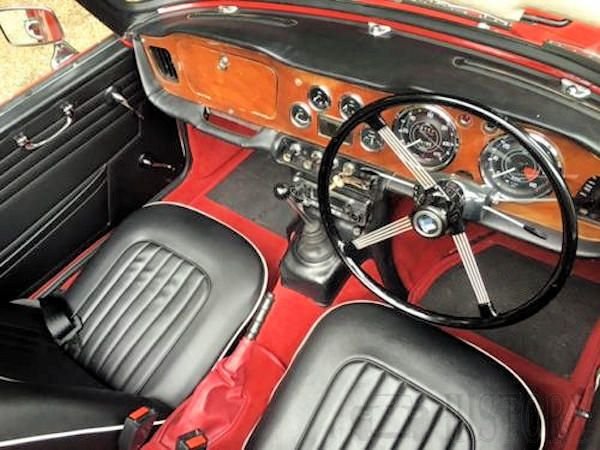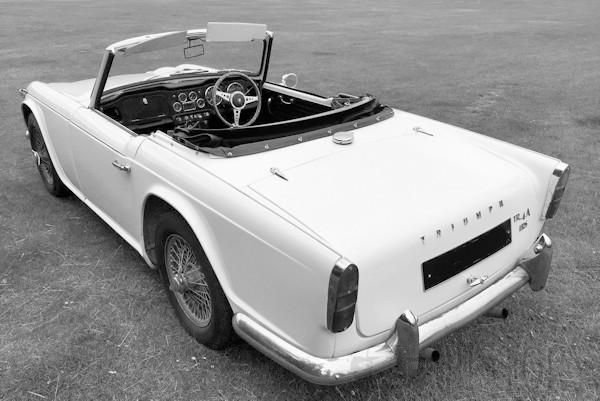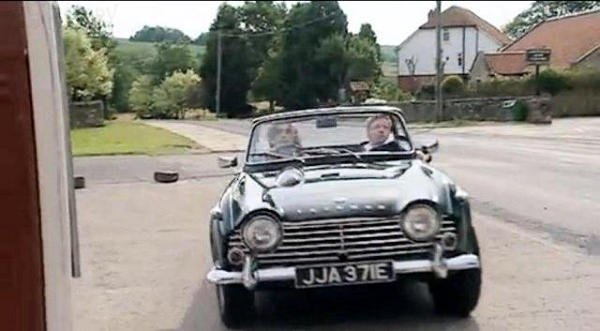Triumph TR4A
| 1965 to 1967 | |
|---|---|
 | |
| Overview | |
| Manufacturer | Triumph Motor Company |
| Production | 1965–1967 |
| Body and chassis | |
| Class | Sports car |
| Body style | 2-door roadster |
| Layout | FR layout |
| Powertrain | |
| Engine | 2,138 cc (2.1 L) I4 |
| Transmission | 4-speed manual |
| Dimensions | |
| Wheelbase | 2,235 mm (88.0 in) |
| Length | 3,962 mm (156.0 in) |
| Width | 1,473 mm (58.0 in) |
| Height | 1,207 mm (47.5 in) |
| Curb weight | 1,016 kg (2,240 lb) |
| Chronology | |
| Predecessor | Triumph TR4 |
| Successor | Triumph TR5 |
The Triumph TR4A was built between 1965 and 1968 by the Triumph Motor Company in the United Kingdom.
The TR4A was an evolution of the TR4, updated with a new chassis. It was hoped the new, but more complex independent rear suspension would address the buying public's desire for more comfortable riding sports cars. This version has an "IRS" badge on the rear. It has been estimated that 75 percent of TR4A were built with IRS. In 1965 the TR4A IRS sold in the UK for approximately £968, with wire wheels and knock-on hubs being another £36, overdrive £51, heater £13 and seat belts £4 each; it sold for just under $2500 in the US.Engine: 2138 cc, 4-cylinder, 86 mm bore, 92 mm stroke, 9:1 compression ratio, 104 bhp (78 kW). The long stroke give this engine much of its torque. Standard inline-four engine
PERFORMANCE
- engine capacity 130.46 cu in, 2,138 cu cm
- fuel consumption 24.5 m/imp gal, 20.4 m/US gal, 11.5 1 x 100 km
- max speed 110 mph, 177.1 km/h
- max power (SAE): 105 hp at 4,750 rpm
- max torque (SAE): 85 1b ft, 11.7 kg m at 3,350 rpm
- max engine rpm: 5,500
- specific power: 49.1 hp/l
- power-weight ratio: 20.3 lb/hp, 9.2 kg/hp
- acceleration: standing 1/4 mile 17.9 sec, O—50 mph (O—80 km/h) 8.2 sec
- max speeds: 30 mph, 48.3 km/h in 1st gear; 50 mph, 80.5 km/h
- in 2nd gear; 75 mph, 120.7 km/h in 3rd gear; 110 mph, 177.1 km/h in 4th gear

In response to dealer requests, about 25 percent of TR4As were produced with a solid rear axle option (also called a live axle), similar to the earlier TR4. Also a under 2.0L spec engine for competition use aswell as competition suspension. The TR4A was the first vehicle to offer an option for axle type.The new suspension eventually proved itself with the buying public and in racing, with three TR4A IRS models posting a team win and finishing 1st, 2nd and 3rd in class at the Sebring 12-hour race of 1966.
Competition engine (for under 2.0L class)
- engine capacity 121.49 cu in, 1,991 cu cm
- bore and stroke 3.27 x 3.62 in, 83 x 92 mm
- max power (SAE) 101 hp at 5,000 rpm
- max torque 118 1b ft, 16.3 kg m at 3,000 rpm
- 8.5 compression ratio, 50.7 hp/l
- specific power, max speed 103 mph, 165.8 km/h.

In 1968 the TR4A was replaced by the 6-cylinder TR5 (European model with fuel injection) and TR250 (US model with twin carburetors), both of which used the same body design.

Coachwork
Like the TR4, the TR4A was also available with the "Surrey Top" hard top system; a weather protection system with rigid rear section including the rear window and removable fabric section over the driver's and passenger's heads. This aesthetically foreshadowed the silhouette of Targa top cars.
Film and TV
A Triumph TR4A in the Heartbeat, TV series

Rating
Technical
-
Triumph TR4A Technical details and specifications (1965-1967)
ENGINE
location front, 4 stroke
cylinders: 4, vertical, In line
bore and stroke: 3.39 x 3.62 In, 86 X 92 mm
engine capacity: 130.46 cu In, 2,138 cu cm
compression ratio: 9
cylinder block: cast iron
cylinder head: cast iron, wet liners
crankshaft bearings: 3
valves: 2 per cylinder, overhead, in line, push-rods and rockers
camshafts: 1, side
lubrication: rotary pump, full flow filter
lubricating system capacity: 11 imp pt, 13.11 US pt
carburation: 2 Stromberg 1-75 CD horizontal carburettors
fuel feed: mechanical pump
cooling system: water
TRANSMISSION
driving wheels: rear
clutch: single dry plate, hydraulically controlled
gearbox: mechanical; gears: 4+ reverse
synchromesh gears: all
gearbox ratios: I 3.140, II 2.010, III 1.330, IV 1, rev 3.220
(option) Laycock-de Normanville overdrive on 2nd, 3rd and 4th
gear lever location: central;
final drive: hypoid bevel
axle ratio: 3.700 (option) 4.100CHASSIS
type box-type ladder frame, X cross members
front suspension: independent, wishbones, coil springs, antj-roll bar, telescopic dampers
rear suspension: independent, semi-trailing arms, coil springs, telescopic dampers.
(option) anti-roll bar on front suspension
(option) competition suspensionSTEERING
rack-and-pinion
turns of steering wheel lock to lock: 3.25.
turning circle (between walls): 35.4 ft, 10.8 mBRAKES
front disc (diameter 9 in, 229 mm), rear drum.ELECTRICAL EQUIPMENT
voltage: 12 V
battery: 57 Ah
generator type: dynamo, 264 W
ignition distributor: LucasDIMENSIONS AND WEIGHT
wheel base: 88.19 in, 2,240 mm
front track: 49.02 in, 1,245 mm
rear track: 48.50 in, 1,232 mm
overall length: 155.90 in, 3,960 mm
overall width: 57.87 in, 1,470 mm
overall height: 50 in, 1,270 mm
ground clearance: 5.90 in, 150 mm
dry weight: 2,128 1b, 965 kg
distribution of weight: 54% front axle, 46% rear axle© Motor car History
-
Triumph TR4A Maintenance and Service Guide (1965-1967)
fuel type: 100 oct petrol
engine oil change: 11 imp pt, 13.11 US pt, 6.2 1, SAE 20 (winter) 30 (summer), change every 3,000 miles, 4,800 km
cooling system capacity: 14.08 imp pt, 16.91 US pt
gearbox oil: 1.50 imp pt, 1.69 US pt, 0.8 1, SAE 90, change every 12,000 miles, 19,300 km
final drive oil: 1.50 imp pt, 1.69 US pt, 0.8 1, SAE 90, change every 6,000 miles, 9,700 km
greasing: none
tappet clearances: inlet 0.010 in, 0.25 mm, exhaust 0.010 in, 0.25 mm
valve timing: inlet opens 17° before tdc and closes 57° after bdc, exhaust opens 57° before bdc and closes 17° after tdc
normal tyre pressure: front 22 psi, 1.5 atm, rear 24 psi, 1.7 atm.
tyres: 5.90 x 15
fuel tank capacity: 11.7 imp gal, 14 US gal
carrying capacity: 529 1b, 240 kg© Motor car History




